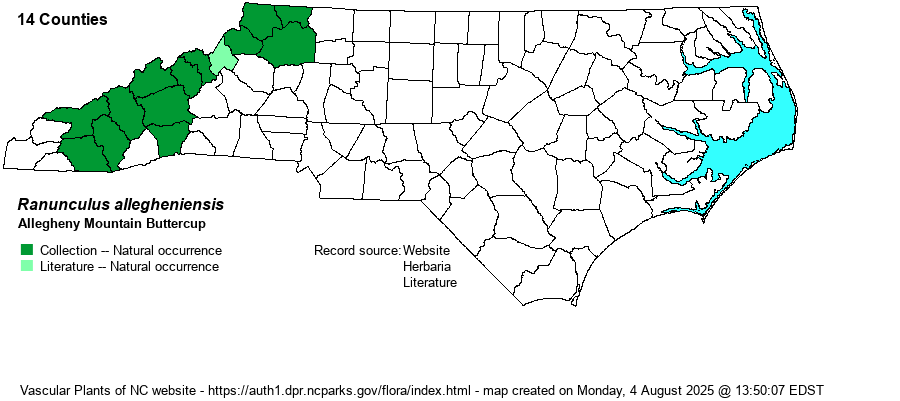| Author | Britton | |
| Distribution | Nearly throughout the Mountains, possibly occurring in all counties, but no records known for the southwestern tip yet. Does not occur in the Piedmont.
This species is generally restricted to the Appalachian Mountains and adjacent areas to the west. It ranges from VT and NY, southwest to western NC and eastern TN. | |
| Abundance | Rare to locally uncommon. This is a Watch List species, as identified by the NCNHP. | |
| Habitat | This is a species of rich forests, mostly over circumneutral soil. It is most frequently found in Rich Cove Forests, but it can be found along small streams and forested seepages, less so into more mesic forests (but there more where clearly high pH soil). |
| Phenology | Blooms from April to June, and fruits shortly after flowering. | |
| Identification | This buttercup species is very similar to the far more common R. abortivus, which also grows in the same range in the state and into the Piedmont and Coastal Plain. Both have several basal leaves on petioles 1-2 inches long, and with kidney-shaped blades about 1 inch wide and nearly as long. The margins are scalloped. The flowering stem or stems -- often reaching 1.5 feet tall -- has different leaves, as they are alternate, sessile, and strongly divided into 3-5 segments. At the ends of the several short branches are the quite small flowers. The flowers are barely 1/4-inch across, consisting of 5 light yellow sepals, with the petals much shorter and somewhat hidden. In this species, the sepals tend to be swept back instead of spreading as in R. abortivus. The several technical character differences are: in this species the sepals are hairy versus mostly smooth in R. abortivus; the petals are less than half as long as the sepals, as opposed to greater than half as long in R. abortivus; and this species has a microscopically longer achene beak. The flower stalks also are somewhat hairy in this species, versus smoother in R. abortivus. As a general rule, in the mountains where both occur, the very common R. abortivus should be found in flat or near-flat ground, often in sun or partial shade, in wet meadows, damp thicket margins, along stream margins, and in various disturbed places. Allegheny Mountain Buttercup occurs more often in higher quality sites, on slopes, forested seepages, and in rich cove forests. The swept-back sepals and some hairs on the flower stalks also might be helpful, if flowers are present. | |
| Taxonomic Comments | None
| |
| Other Common Name(s) | Allegheny Buttercup, Mountain Crowfoot, Allegheny Mountain Crowfoot. Note that the tiny-flowered species of buttercups often have the common name of "crowfoot". | |
| State Rank | S2 | |
| Global Rank | G4 | |
| State Status | W7 [W1] | |
| US Status | | |
| USACE-agcp | FACU link |
| USACE-emp | FAC link |

